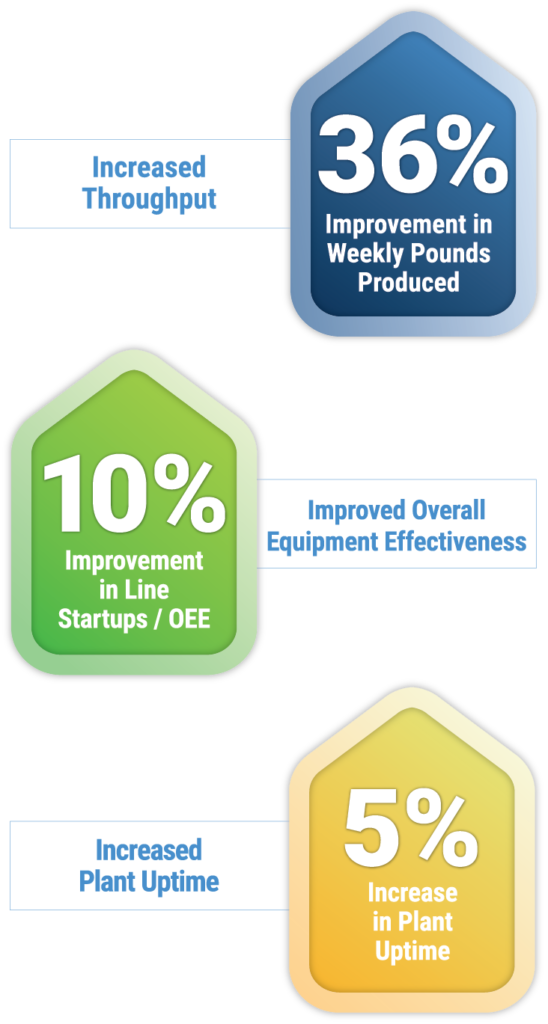
Looking to increase operational performance to actual capacity, meet customer demand, and train newly-promoted frontline supervisors, our client turned to the team at POWERS. The results? Our client sprinted to a 36% improvement in throughput, 10% improvement in OEE, and 5% improvement in uptime!

Project Overview

Performance Results
Background
Our client is a decades-old American consumer-goods manufacturer that operates in more than 40 countries and has sold its category-leading products in over 180 countries worldwide.
Their products include well-known, established food, beverage, and household goods brands. They operate numerous facilities across the country and have historically employed more than 137,000 people.
Situation
Although our client has had a track record of success for decades, the company has recently experienced successive years of financial losses.
Like many consumer packaged goods (CPG) manufacturers dealing with fluctuating demand, labor, and supply chain issues surrounding the pandemic, this high-performing operation was experiencing significant production challenges.

POWERS’ Productivity Sprint Drives Tasty 36% Improvement in Throughput for Global Food, Beverage, and Household Goods Manufacturer
Looking to increase operational performance to actual capacity, meet customer demand, and train newly-promoted frontline supervisors, our client turned to the team at POWERS. The results? Our client sprinted to a 36% improvement in throughput, 10% improvement in OEE, and 5% improvement in uptime!
Background
Our client is a decades-old American consumer-goods manufacturer that operates in more than 40 countries and has sold its category-leading products in over 180 countries worldwide.
Their products include well-known, established food, beverage, and household goods brands. They operate numerous facilities across the country and have historically employed more than 137,000 people.
Situation
Although our client has had a track record of success for decades, the company has recently experienced successive years of financial losses. Like many consumer packaged goods (CPG) manufacturers dealing with fluctuating demand, labor, and supply chain issues surrounding the pandemic, this high-performing operation was experiencing significant production challenges.
Analysis
Senior management was operating the business on historical performance rather than actual capacity, which masked significant production waste and lost time. As a result, schedule attainment, customer delivery, and satisfaction suffered due to this low performance.
In addition, critical skills had eroded across their workforce due to longtime and experienced employee retirement, turnover, and lack of investment in training and developing their associates.
Instead, as we often find, the company's daily "firefighting" consumed the attention of frontline supervisors, coupled with expectations far below their actual capabilities. In this daily chaos to meet demand, frontline leadership lacked the focus and training to get performance back on track.
To further hinder performance, the company did not have the critical information necessary for decision-making, forecasting, execution, or evaluation.
In addition, a lack of essential skills within the operations and maintenance departments created plant-wide performance gaps when only a handful of critical associates were absent.
Line startups, a crucial point of potential lost productivity, suffered from poor coordination, communication, and alignment between cross-function departments leading to ineffective production line startups and lagging daily performance.
Without predictive or preventive maintenance procedures in place, their reactive or "run to failure" maintenance approach created significant unscheduled downtime that further eroded daily performance.
Further contributing to lost productivity, senior leadership set expectations for frontline managers far below actual capabilities. The business was managed on historical performance rather than actual capacity, masking many issues and critical lost time.
And finally, without the critical investment in their people, no management processes, disciplines, or skills existed to build and foster a proactive, initiative-taking, performance-based culture.
Plan
After our in-depth and time-sensitive assessment, we implemented a cross-functional department performance sprint to align and improve communication and execution of daily plant startups and shift handoffs. These are critical points of daily lost productivity, and we implemented improvements immediately.
Our team, working with maintenance and production partners, created standardized startup routines to reduce preventable downtime and operator errors.
We identified and began to fill the gap in critical skills and needs across the plant's frontline leadership and workforce.
We calculated the actual capacities of the business so that managers could perform and be evaluated against that level.
We worked alongside frontline supervisors to identify, train, coach, and improve necessary behaviors to execute the new performance standards and vision.
In addition, we trained and coached frontline supervisors on identifying and eliminating critical operating problems.
We taught frontline supervisors decision-making skills to improve daily performance. And we trained their frontline leaders to identify and remove ineffective processes that historically led to waste and lost time, impacting performance.
Results
Our approach resulted in significant operational performance improvements as well as more cohesive, engaged, and better-trained frontline leaders.
The POWERS team orchestrated a 36% improvement in weekly pounds produced for our partner, leading to improved schedule attainment and customer delivery.
Our team facilitated a 10% improvement in line startups, with an overall OEE (Overall Equipment Effectiveness) improvement of 10% in less than ten weeks.
A highlight of the performance increases included two production lines with an OEE improvement of 20% over their base.
Overall, plant uptime increased by 5% across all shifts.





